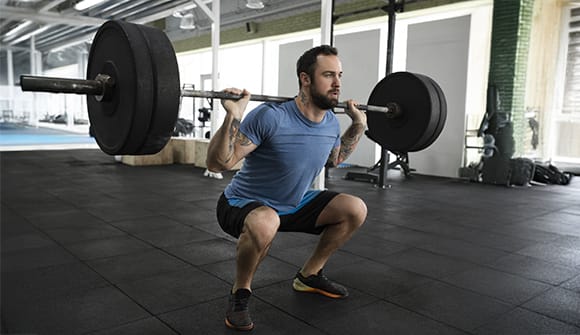Don't overstrain in your quest to gain
Proper techniques to protect your spine while lifting weights.
Article Author: Deborah Circelli
Article Date:

With the rise in popularity of high-intensity training, it’s important for fitness enthusiasts to remember not to overdo it when working out.
Improper training or weightlifting could lead to serious neck and spine injuries such as a disk herniation in the neck or back, or in rare cases, a fracture in the lower back.
Adam Polifka, MD, a neurosurgeon with Lyerly Neurosurgery at Baptist Health, has seen an increase in injuries primarily caused by people improperly lifting weights or using weights that are too heavy.
But Dr. Polifka, who goes to the gym four or five times a week, said there are steps you can take to protect yourself. Maintaining a healthy lifestyle and weight is key to keeping a healthy spine. For example, he performs a combination of cardiovascular exercise and weight training, in addition to spending free time playing golf, wakesurfing, and skiing in the winter.
“Going to the gym and maintaining a good regimen of both cardiovascular activities and weight training is one of the best things you can do for your spine,” Dr. Polifka said. “I think it’s also important to switch things up and have activities you enjoy doing while also getting exercise so you can avoid monotony and stay engaged.”
4 ways to protect your back while weight training
Dr. Polifka offered these additional tips to help prevent injury while lifting weights.
1. Don't skip the warmup
Even if you're short on time, take a moment to stretch and warm up properly. Warming up is the most important part of your exercise routine because it allows you to ease into a light movement while gradually raising your heart rate and oxygen to the body.
A good stretch will help increase flexibility and blood flow to the muscles. It's important to remember not to stretch a cold muscle.
“Whenever you start any workout, stretch and warm up gradually,” Dr. Polifka said. “Don't immediately go into a strenuous activity or whatever exercise you're doing without warming up and getting those muscles engaged to avoid injury.”
2. Develop core strength
While it’s fine to do squats and deadlift exercises, be sure you're engaging your core muscles.
“Having strong abdominal muscles and a strong lower back, and also doing exercises to engage those muscles, is really critical for long-term spine health,” Dr. Polifka said.
The major muscles of the core include internal and external obliques (on the sides of the abdomen), erector spinae (muscles along the spine), diaphragm, pelvic floor muscles, transverse abdominis (deep abdominal muscles) and rectus abdominus (six-pack abs). Engaging your core before lifting ensures all the support and stability muscles are active before you take on the extra weight.
3. Use proper form
If you're new to lifting weights, don't rely on learning by watching other people work out at the gym; they may not be using proper form. Consult a trainer to make sure you're doing the exercises correctly and using the recommended weight range. You can also go online to find resources, including videos, apps and classes to learn proper techniques.
Most back injuries from lifting are caused by improper technique or form, which can add unnecessary stress to the lower back.
Some examples of things to avoid when lifting include:
- Carrying the weight far away from your body
- Rounding your back
- Twisting
- Making jerking movements
4. Start slowly
Another mistake people make when they start weightlifting is going too big. Trying to lift a weight that's too heavy can result in poor form, strained or torn muscles, lack of control or dropping the weight, and injury.
“It’s important when you're first starting out to really focus on not overstraining by lifting too much weight. Instead, focus more on maintaining the correct form,” Dr. Polifka said. “You will actually get more benefit from lifting less weight, both from what it will do for your strength, and also helping to minimize injury."
“There is always this tendency to want to compete and increase the weight you're lifting, but it really should be about focusing on the internal progress of how your overall fitness is doing as opposed to the number you're putting up on the bar,” he added. “Focus more on the benefits you're doing for your body and not on constantly trying to achieve a personal best.”
When to seek professional help
Lifting weights can come with minor sprains and strains.
Dr. Polifka said to listen to your body if something goes beyond a typical muscle strain or you develop debilitating pain that’s not improving with standard rest, anti-inflammatory medication and ice. If problems are persisting, it’s time to see your primary care doctor, who may refer you to a specialist.
Don't ignore your back or neck pain
Our specialists are here to help you find a personalized and effective treatment so you can get back to doing the things you love, without pain. To learn more about comprehensive back pain treatment options, visit baptistjax.com/back.


